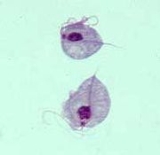
Trichomonad
Encyclopedia
The trichomonads are an order of anaerobic protist
s, included with the parabasalid
s. Most are either parasites or other endosymbiont
s of animals. They typically have four to six flagella
at the cell's apical pole, one of which is recurrent - that is, it runs along a surface wave, giving the aspect of an undulating membrane. Like other parabasalids they typically have an axostyle
, pelta, costa and parabasal bodies
. In Histomonas there is only one flagellum and a reduced axostyle, and in Dientamoeba both are absent.
Trichomonads reproduce by a special form of longitudinal fission, leading to large numbers of trophozoites in a relatively short time. Cyst
s never form, so transmission from one host to another is always based on direct contact between the sites they occupy.
Some organisms in this order include:
Protist
Protists are a diverse group of eukaryotic microorganisms. Historically, protists were treated as the kingdom Protista, which includes mostly unicellular organisms that do not fit into the other kingdoms, but this group is contested in modern taxonomy...
s, included with the parabasalid
Parabasalid
The parabasalids are group of flagellate protozoa, most of which are symbiotic in animals. These include a variety of forms found in the guts of termites and cockroaches, many of which have symbiotic bacteria that help them digest wood. Some other species are human pathogens.-Characteristics:The...
s. Most are either parasites or other endosymbiont
Endosymbiont
An endosymbiont is any organism that lives within the body or cells of another organism, i.e. forming an endosymbiosis...
s of animals. They typically have four to six flagella
Flagellum
A flagellum is a tail-like projection that protrudes from the cell body of certain prokaryotic and eukaryotic cells, and plays the dual role of locomotion and sense organ, being sensitive to chemicals and temperatures outside the cell. There are some notable differences between prokaryotic and...
at the cell's apical pole, one of which is recurrent - that is, it runs along a surface wave, giving the aspect of an undulating membrane. Like other parabasalids they typically have an axostyle
Axostyle
An axostyle is a sheet of microtubules found in certain microbial eukaryotes. It arises from the bases of the flagella, sometimes projecting beyond the end of the cell, and is often flexible or contractile, and so may be involved in movement and provides support for the cell...
, pelta, costa and parabasal bodies
Basal body
A basal body is an organelle formed from a centriole, and a short cylindrical array of microtubules. It is found at the base of a eukaryotic undulipodium and serves as a nucleation site for the growth of the axoneme microtubules...
. In Histomonas there is only one flagellum and a reduced axostyle, and in Dientamoeba both are absent.
Trichomonads reproduce by a special form of longitudinal fission, leading to large numbers of trophozoites in a relatively short time. Cyst
Cyst
A cyst is a closed sac, having a distinct membrane and division on the nearby tissue. It may contain air, fluids, or semi-solid material. A collection of pus is called an abscess, not a cyst. Once formed, a cyst could go away on its own or may have to be removed through surgery.- Locations :* Acne...
s never form, so transmission from one host to another is always based on direct contact between the sites they occupy.
Some organisms in this order include:
- Trichomonas vaginalisTrichomonas vaginalisTrichomonas vaginalis is an anaerobic, flagellated protozoan, a form of microorganism. The parasitic microorganism is the causative agent of trichomoniasis, and is the most common pathogenic protozoan infection of humans in industrialized countries. Infection rates between men and women are the...
, an organism living inside the vagina of humans - Dientamoeba fragilisDientamoeba fragilisDientamoeba fragilis is a single celled parasite found in the gastrointestinal tract of some humans, pigs and gorillas. In some people it causes gastrointestinal upset while in others it does not...
, parasitic ameboid in humans - Histomonas meleagridisHistomonas meleagridisHistomonas meleagridis is species of parasitic protozoan that infects a wide range of birds including chickens, turkeys, peafowl, quail and pheasants, causing blackhead disease, infectious enterohepatitis, or histomoniasis. H. meleagridis can infect many birds but it is most deadly in turkeys...
, parasite that causes blackhead disease in poultry. - Mixotricha paradoxaMixotricha paradoxaMixotricha paradoxa is a species of protozoan that lives inside the termite species Mastotermes darwiniensis and has multiple bacterial symbionts. The name, given by the Australian biologist J.L. Sutherland, who first described Mixotricha in 1933,. means “the paradoxical being with mixed-up...
, a symbiotic organism inside termites, host of endosymbionts.

